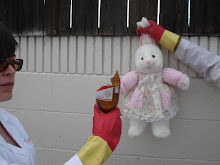The San Andreas Fault is the reason behind all sorts of landforms we see across California. Let’s start by looking at a map of this guy:

Anywho, start with your eyes on the northern most part of the red line and then trace the red line southwards, towards Los Angeles. You’ll get to a point just south of the Great Valley (the Armpit of California) where you’ll see that the fault curves a bit inland. This curve is called “The Big Bend” and causes all sorts of interesting things to happen, geologically speaking.
For one, the Big Bend is responsible for the uplift of the Transverse Ranges.
 This range of mountains is an oddball because it runs East-West, while everything else around us (the Coast Ranges, the Sierra Nevadas, the Rockies, the Cascades) runs North-South. Why you ask? Well, think of the Pacific plate moving northward and rubbin’ up against the North American plate. It’s cruisin’ along, carrying with it all those rocks and houses and dogs and buildings and burrito shops that exist west of the San Andreas. At the Big Bend, however, all that stuff is crashing into one another instead of smoothly moving along past one another. That seemingly innocuous curve in the fault has created a big, fat convergent zone in the area around the Big Bend. This convergent zone includes the Los Angeles region. Lucky us!
This range of mountains is an oddball because it runs East-West, while everything else around us (the Coast Ranges, the Sierra Nevadas, the Rockies, the Cascades) runs North-South. Why you ask? Well, think of the Pacific plate moving northward and rubbin’ up against the North American plate. It’s cruisin’ along, carrying with it all those rocks and houses and dogs and buildings and burrito shops that exist west of the San Andreas. At the Big Bend, however, all that stuff is crashing into one another instead of smoothly moving along past one another. That seemingly innocuous curve in the fault has created a big, fat convergent zone in the area around the Big Bend. This convergent zone includes the Los Angeles region. Lucky us! Along with the Transverse Ranges, we get the Garlock Fault out of all this Big Bend business. The Garlock is one of the larger lateral faults in California. If you’re ever flying north from Southern California, you can actually tell where this fault runs visually if you look out your airplane window. Pretty neat, huh? Make sure to point it out to the person sleeping next to you by saying “Hey, look look! That’s the Garlock fault! It’s a left-lateral strike slip fault that defines the boundary between the Mojave block and the Sierra Nevada/Basin and Range province!” I advise to also make sure to spit a lot when you talk and maybe sneeze on them once or twice because you are a nerd and should behave thusly.
Along with the Transverse Ranges, we get the Garlock Fault out of all this Big Bend business. The Garlock is one of the larger lateral faults in California. If you’re ever flying north from Southern California, you can actually tell where this fault runs visually if you look out your airplane window. Pretty neat, huh? Make sure to point it out to the person sleeping next to you by saying “Hey, look look! That’s the Garlock fault! It’s a left-lateral strike slip fault that defines the boundary between the Mojave block and the Sierra Nevada/Basin and Range province!” I advise to also make sure to spit a lot when you talk and maybe sneeze on them once or twice because you are a nerd and should behave thusly.
NEEEERRRRDDDD!



